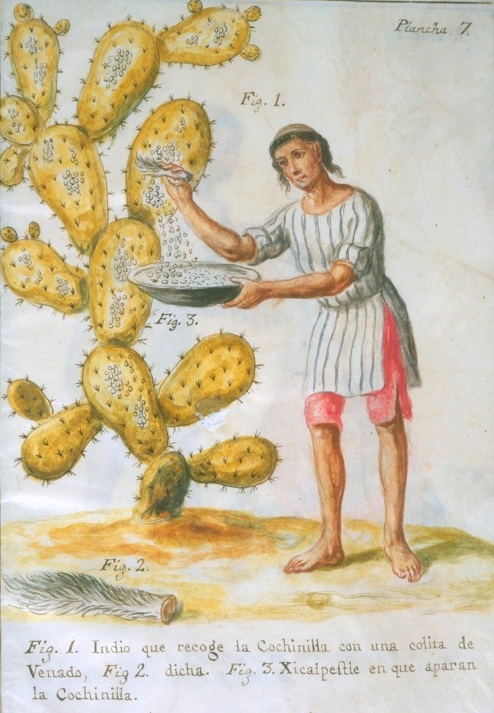
A Perfect Red is a marvelous story about the history of the “discovery” of cochineal by Europe in the 16th century. The tiny scale insect is one of the most compelling red colors in the natural dye palette and its introduction took Europe by a storm, garnering huge fortunes for Spain and England (who pirated tons of cochineal bounty from Spain).
Author Amy Butler Greenfield details the challenges that it took to bring this dyestuff to market from the fall of the Aztec empire to Perkin’s discovery of mauve. Her 300-page book reads like a natural dye bodice-ripping historical romance without the bodices and is full of richly drawn characters: conquistadors, swashbucklers, royalty, merchants, indigenous uprisings and secretive dyer’s guilds. Highly recommended reading.
The past few years of the Great Cochineal Upheaval have felt like a chapter from Greenfield’s book. In the fall of 2009 we were greeted with the news that there was no cochineal extract available. Cochineal growers decided that the cost and effort of raising cochineal was too steep for the prices they were being paid and they plowed under their nopal cactus fields and planted cash crops such as artichokes and kiwis. As cochineal is also one of the major natural food colorants that is approved in the US, Brazil and the European Union, prices naturally spiked, rising to levels we had never seen before and we found ourselves priced out of the cochineal market. We have been anxiously monitoring the situation and early this spring we were told to wait another year because they were using most of the harvest to re-seed the fields.
Dyers were dejected. Even though lac and madder filled some of the gap in our red palette, the workarounds to those wonderful cochineal fuchsia, red, pink and purple colors just weren’t the same. Finally the price for cochineal insects started declining and we just received word that the price for cochineal extract is at its lowest point since the turmoil began. Taking a deep breath, we jumped in and purchased some extract.
It is a simply beautiful, very high quality colorant. Rich, red and glowing, it instantly energizes the palette. The purples with cochineal are unbelievably vibrant and it makes a very perfect (and more economical) fire engine red when combined with madder. It is so potent that 2% plus some cream of tartar in the dyebath makes a stunning deep crimson color on wool.
Cochineal dyes to its deepest shades when you use a higher percentage of alum mordant (15-20%) and some cream of tartar in the dye bath (2-6% depending if you also mordanted with COT). If you have mineralized or hard water with calcium, magnesium or iron in it, use filtered or distilled water for the clearest colors.
